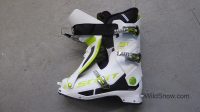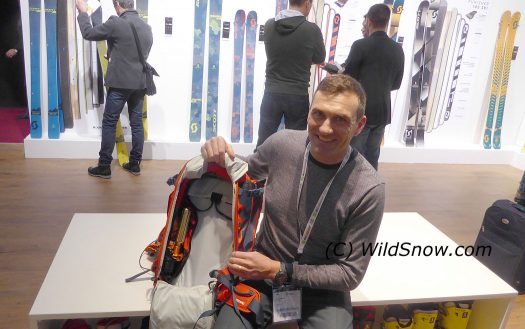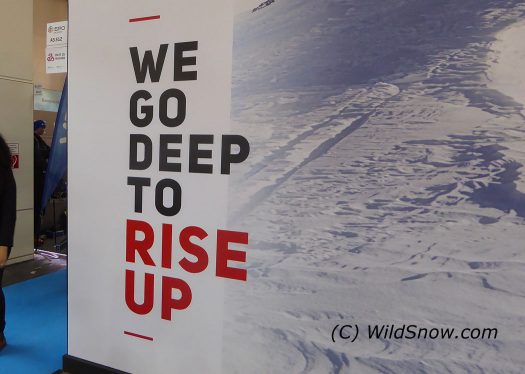
ISPO, land of the odd European English marketing slogans. What does it mean!? Sounds like a yoga seminar or political protest march?
How to organize my ISPO reports? This year, I’ll do it by brand until I burn out my finger tendons. Then I’ll write about the beer halls of Munich or something equally as mundane. Perhaps, skiing?
I like ISPO Munich. The vast variety of brands is never ending buzz for a mouth breathing gear blogger, and the intense European enthusiasm of the place takes over when the basic psych wears off (excellent espresso at every booth helps as well). I love how easy it is to navigate the halls — even though we’re talking 2,500 exhibitors and who knows how many miles of passages (the conference center is Munich’s older decommissioned international airport). Most of all, I come here to have direct contact with principle people of the ski touring gear business who might not be at the shows in North America.
Getting around ISPO is easy exactly because of the old airport layout; mezzanines with people movers that take you to a series of “halls” shooting perpendicular to the magic carpets.
Since we’re not a gear blog, I don’t have to hit all 2,500 stands. Instead, I make an easy number of appointments each day for folks we feel are the core ski touring outfits, and who we feel we collaborate best with.
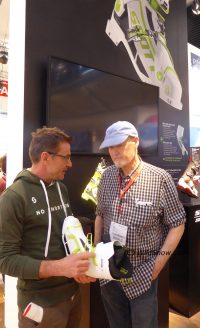
Myself and Herve Maneint discuss the interesting Scott S1, is that a bemused expression on my face, or perhaps total acceptance of Scott’s world domination? Conversations such as this is why I go to the effort and expense of attending ISPO Munich.
Along those lines, Scott is always a good hit. Since their strong entry into ski touring a few years ago, they haven’t stopped innovating.
This season, just about every backcountry skier I’ve spoken with here has an opinion about Scott’s out-of-box thinking on swapping the traditional lean-lock from the back of their S1 ski boots to the front. I got my own pair of these guys on-snow just before leaving the U.S., and found the concept to work surprisingly well (with caveats, specific review coming).
Over arching problem for myself and others trying these boots: the buckles were difficult to operate. It took me longer to buckle the boots than it did to complete a subsequent ski tour (joking, but that’s nearly the truth)!
That’s of course something that could never go to retail, and was specific to the samples. I often don’t mention this sort of thing, but do so here for two reasons. First, it was funny. Second and more importantly, quite a few people have tried on the S1 and had their thoughts dominated by the buckle situation. We all need to get past that.
Thus I’m happy to report that we can all breath a sigh of relief now, as Scott’s boot designer Herve Maneint told me in no small words that they’ll be ditching the current buckles and going with something more basic and easy to operate. Nice. Now I can talk about what really matters. According to Herve they’ll be making the upper buckle strap wider so it’ll ostensibly do the role of both buckle and power strap. Further, they’ll add an optional spoiler to the shell cuff for those of us with skinny legs. Nice also to hear the S1 offerings will have boot-boards to help with custom fitting.
During our meeting, Herve was adamant about his leather liner option being incredibly comfortable due to the unique way leather conforms to your foot shape. I’m eager to try that, since I’ve always had a problem with the skinny rear part of my foot not quite getting optimal fit, even with heat molding.
Per your questions here, dear readers, I also quizzed Herve on the punch-ability of these boots. As we suspected, the S1 Carbon 130 is not moldable at the mets (ball of foot) due to the carbon insert. the S1 Longfiber 120, however, has reinforcement inserts made with a Grilamid mix that’s said to punch just fine. My testing revealed the 130 version to be much stiffer than I need in a boot, and I think that’s probably true for most people doing human powered vertical. Thus, if you’re considering being an early adopter of the S1, know that the 120 version might be a better choice.
Herve was the right guy to speak with about the S1 boot engineering basis. He emphasized that a common and enjoyable style of skiing involves a balanced stance with much of the turn feeling as if it originates from the ball of your foot. A conventional cuff boot, he said, has the disadvantage of a force vector at your heel where the cuff pivots are, and ignores if not fights against what happens with your forefoot. The S1 system flops things and puts the pivots at your metatarsal, and gives you “that wonderful flowing feeling,” (please accompany previous quote with French skiing hand gestures).”
I think Scott might be onto something with this, but know this first public iteration of the concept is most certainly due for numerous tweaks over coming seasons. At the least, for those of us with compromised ankles and such, it’s incredibly easy to slip your foot into the S1, what with the “clamshell” quasi rear-entry cuff arrangement. Ease of entry and overall stiffness aside, success of anything this new and different is going to depend on benefits easily compensating for hassles or differences in performance. Like I said, time will tell, look for a review in this space.
Whoops, almost forgot. What’s going on with the Scott version of the Alpride Airbag system? They’ve trimmed a few hundred grams from the total pack weight (some from the plumbing, and some from the packs.) The plumbing is now mounted to the side, freeing up the cargo compartment for easier packing. The reworked gas valve system is minimalist, strong and light. Trigger is improved. Delightful progress we expect will continue. Indeed, look for what I don’t think is an exaggeration to call the “airbag wars of 2017,” beginning next fall. (See our other Alpride posts.)
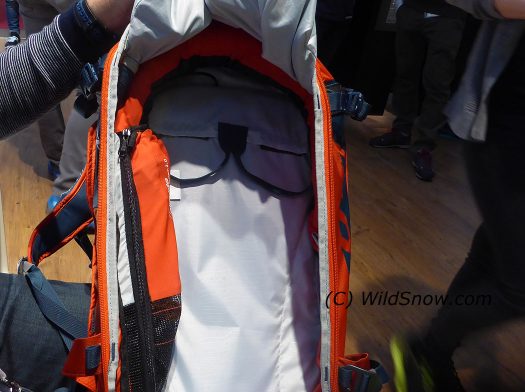
New Alpride is lighter, with more room inside due to entirely new location of the plumbing (to the side instead of middle).
(Ear to the ground report: At least three younger freeriders here at ISPO told me they’re tired of all the airbag hype, that “everyone has one, even people hiking up the piste” and “they’re a lot less effective than the industry is making them out to be.” I’d tend to agree. In my view, even the slightest inclination to ski something with an airbag on your back that you otherwise would not ski 110% negates any added chances of you surviving your backcountry skiing career. The examined life asks that we would all look inward and be honest about this — and be sure that plumbing on your back isn’t creating a fantasy in your head.
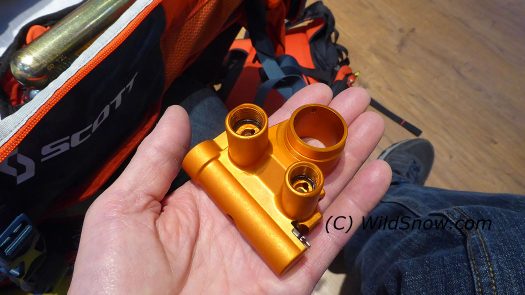
Airbag rucksack makers at ISPO are all eager to show of their plumbing… the aluminum variety, that is. This is the Alpride valve system.
WildSnow.com publisher emeritus and founder Lou (Louis Dawson) has a 50+ years career in climbing, backcountry skiing and ski mountaineering. He was the first person in history to ski down all 54 Colorado 14,000-foot peaks, has authored numerous books about about backcountry skiing, and has skied from the summit of Denali in Alaska, North America’s highest mountain.

